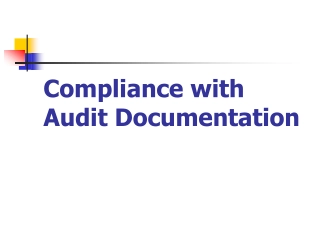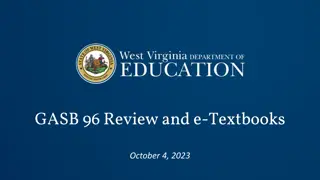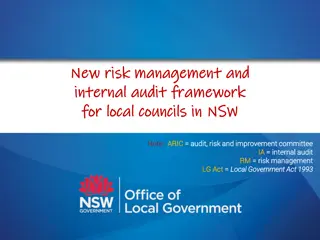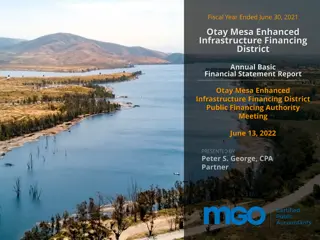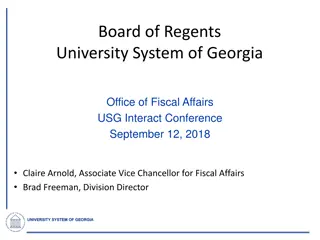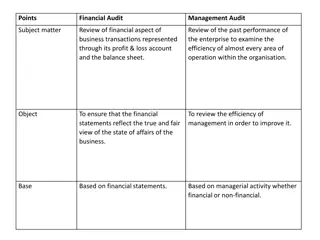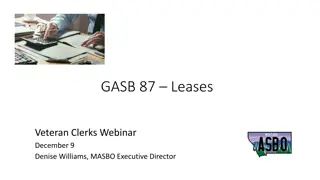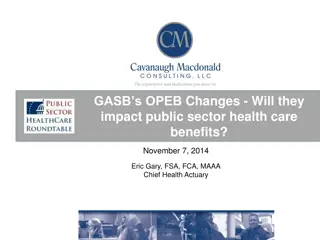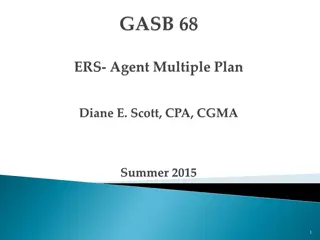Summary of Audit Approach and GASB Statement Changes
GASB Statement 68 signals a shift in financial reporting for public pension plans, emphasizing liability recognition and reporting requirements for participating employers. The completeness assertion risk approach details the sampling process, while AICPA whitepapers delve into issues related to employer reporting. The content covers a range of topics including schedule disclosures, pension amounts, and audit approaches.
Download Presentation

Please find below an Image/Link to download the presentation.
The content on the website is provided AS IS for your information and personal use only. It may not be sold, licensed, or shared on other websites without obtaining consent from the author.If you encounter any issues during the download, it is possible that the publisher has removed the file from their server.
You are allowed to download the files provided on this website for personal or commercial use, subject to the condition that they are used lawfully. All files are the property of their respective owners.
The content on the website is provided AS IS for your information and personal use only. It may not be sold, licensed, or shared on other websites without obtaining consent from the author.
E N D
Presentation Transcript
Overall memo related to audit approach and summary of packet Schedules of Employer Allocations & Pension Amounts by Employer SOC 1 Type 2 report Note Disclosures and RSI info for a cost-sharing employer Employer specific info and journal entries 2
AICPA Whitepapers published by State and Local Government Expert Panel Governmental Employer Participation in Cost-Sharing Multiple- Employer Plans: Issues Related to Information for Employer Reporting Single-Employer and Cost-Sharing Multiple-Employer Plans: Issues Associated with Testing Census Data in an Audit of Financial Statements Description of Schedule of Employer Allocations and Schedule of Pension Amounts by Employer Additional information regarding census data testing 3
Completeness Assertion Risk approach How sample was selected: > 20% Contributions every year No employers >5% Contributions once every 5 years 3 employers <2% Contributions in aggregate no testing 40 employers All other employers: 166 employers rotate so that each is tested once every 10 years 5
GASB Statement 68 replaces the financial reporting requirements under GASB Statement 27 for participating employers in public pension plans. Major financial reporting and accounting changes for cost sharing plans include recognizing or reporting: 1. Liability for your proportionate share of the collective net pension liability calculated for all employers in the plan Your proportionate share of collective pension related deferrals and collective pension expense Deferred Inflows and Outflows of Resources of your proportional share of the total (GASB 71 related to Employer Contributions) Additional Note Disclosures and Required Supplementary Information (RSI) 2. 3. 4. 6
1. Specified Element Report 2. Audit opinion by RSA auditors (pages 1-2) 3. Each participating employer s proportion of specified elements is listed (pages 3-13) 4. Notes to schedules (pages 14-17) 5. Notice that some numbers are in dollars and some in thousands 6. Supplementary schedules included: A. Reconciliation of total contributions to contributions used to obtain allocation percentage (FY2013 and FY2014 pages 20-31) B. Amortization of deferred inflows/outflows, Sensitivity of discount rate, Contributions related to calculation of Collective Net Pension Liability (pages 32-34) 7
Reconciliation of total contributions to contributions used to obtain allocation percentage (FY2013 and FY2014 pages 20-31) Total Contributions =Monthly ER Contributions+ Error Service Refunds Reduced Monthly ER Contributions by components of employer rate not considered in calculating the Collective Net Pension Liability: PRDB, TLI, and Admin Expense Reduced Total Contributions by add-on component for two special units Annualized new units Formula: Contributions x (Normal + Accrued Liability Rate) / Total Employer Rate 9
SOC 1 Type 2 report for period Jan 1, 2014Sept 30, 2014 (to be prepared annually) Audit firm: A-lign CPA s Controls reviewed and tested around following : Contributions/Enrollments Investments Disbursements for benefits Valuations and Census Data 10
Provide to your auditors Complimentary User Entity Controls section pages 19-20 Review your organization s controls around the following user entity controls: Enrollment Contributions Census Data Distributions IT General Controls 12
Enrollment-providing timely enrollment forms to new employees Annual checklists promptly process, review, correct and certify to RSA the completeness of the Annual Checklist Completion of non-enrollee forms Timely and accurate termination of employment and last contribution remitted 13
Follows requirements of GASB 68 Contains disclosures specific to TRS for your September 30, 2015 financials These disclosures as presented have been run through a GAAP disclosure checklist relative to GASB 68 and 71 disclosures Note: Summary of Significant Accounting Policies see suggested language Note X this is your note that gives more specific information about the TRS plan References to See Detail Table or Report 14
Valuation Date Measurement Date Measurement Period 2014 Financial Statement Date 2015 Collective Net Pension Liability for 9/30/2013 was rolled forward to 9/30/2014 using standard roll-forward procedures by actuary Valuation Date: September 30, 2013 Measurement Date: September 30, 2014 Measurement Period: Oct 1, 2013-Sept 30, Financial Statement Date: September 30, 16
Proportionate Share of Net Pension Liability GASB 68, paragraph 81a Covered employee payroll Not Covered employee payroll during Measurement Period (FY2014) Schedule of Contributions GASB 68, paragraph 81b Contributions only for normal and accrued liability component of employer rate Covered employee payroll during fiscal year audit report (FY2015) Proportionate Share of Net Pension Liability Not pensionable payroll Measurement Period (FY2014) Schedule of Contributions fiscal year of your 17
Example: Employee 1 Employee 2 Annual Salary: $150,000 Employee 3 Annual Salary: $500,000 Works 5 hours per month Pensionable Payroll*: $260,000 Pensionable Payroll: $0 Pensionable Payroll: $150,000 Covered Payroll: $0 Covered Payroll: $150,000 Covered Payroll: $500,000 * Per IRS Code 26 U.S.C. 401(a)(17), 2014 Annual Pensionable Compensation Limit is $260,000. For 2015- $265,000. 20
Pages 1-2Information necessary for note disclosures Page 3 building blocks for amounts included in journal entries Page 4 Agency specific journal entries First two entries record the beginning amounts of the liability and deferred outflow of resources as of the implementation date (10/1/2014). These entries are only made at implementation. Entry 3 records amounts necessary to amortize the deferred inflows/outflows, adjust proportionate share of liability and record pension expense Entry 4 records the deferred outflow for current year employer contributions in accordance with GASB 71 21
XYZ School System Statement of Net Assets Before After (in thousands) (in thousands) Assets Current Assets $ 15,000 $ 15,000 Deferred Outflows 2,000 Capital Assets 25,000 25,000 Total Assets $ 40,000 $ 42,000 Liabilities Current Liabilities $ 6,000 $ 6,000 Net Pension Liability 26,000 Deferred Inflows 1,000 Total Liabilities $6,000 $ 33,000 Total Net Assets $ 34,000 $ 9,000 26
XYZ School System Statement of Net Assets Before After (in thousands) (in thousands) Assets Current Assets $ 15,000 $ 15,000 Deferred Outflows 2,000 Capital Assets 25,000 25,000 Total Assets $ 40,000 $ 42,000 Liabilities Current Liabilities $ 6,000 $ 6,000 Net Pension Liability 44,000 Deferred Inflows 1,000 Total Liabilities $ 6,000 $ 51,000 Total Net Assets $ 34,000 $ (9,000) 27
1. Economic & Demographic Gains and Losses 2. Changes in Economic & Demographic Assumptions and Inputs 3. Changes in the Proportionate share 4. Difference between projected and actual investment earnings Numbers 1 3 above are to be recognized over the expected service life of active and inactive plan members (5.3 years as of 9/30/13). Number 4 is to be recognized over a closed five year period. 28
Under prior standards, employers report a pension expense equal to their contractually required annual contributions Changes in the NPL will be reported either immediately as a pension expense or over a period of time as deferred outflows/inflows of resources. FY 2014 (amts. in thousands) Pension Expense = + Service Cost $602,605 + Interest on TPL 2,352,804 + Changes in Plan Benefits --- - Member Contribution (480,849) - Projected Earnings on Plan Investments (1,617,082) +/- Recognition of portion of (170,283) deferred inflows/outflows - Pension Expense related to additional (19) rate for special units ___________ Pension Expense to allocate to participating ERs $687,176 29
TRS Retirement Employer Portal Design Requirements- Early 2016 Transition to New Employer Portal May 2017 New data elements will be required Your IT Vendor will need to be involved 31


